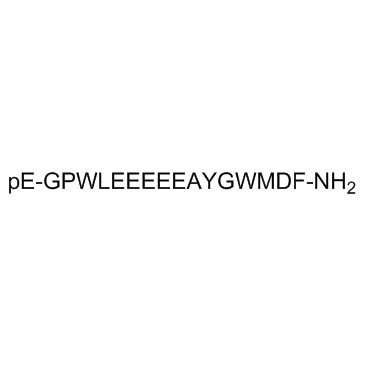10047-33-3
| Name | 5-Oxo-L-prolylglycyl-L-prolyl-L-tryptophyl-L-leucyl-L-α-glutamyl-L-α-glutamyl-L-α-glutamyl-L-α-glutamyl-L-α-glutamyl-L-alanyl-L-tyrosylglycyl-L-tryptophyl-L-methionyl-L-α-aspartyl-L-phenylalaninamide |
|---|---|
| Synonyms |
5-Oxo-L-prolylglycyl-L-prolyl-L-tryptophyl-L-leucyl-L-α-glutamyl-L-α-glutamyl-L-α-glutamyl-L-α-glutamyl-L-α-glutamyl-L-alanyl-L-tyrosylglycyl-L-tryptophyl-L-methionyl-L-α-aspartyl-L-phenylalaninamide
EINECS 233-157-0 L-Phenylalaninamide, 5-oxo-L-prolylglycyl-L-prolyl-L-tryptophyl-L-leucyl-L-α-glutamyl-L-α-glutamyl-L-α-glutamyl-L-α-glutamyl-L-α-glutamyl-L-alanyl-L-tyrosylglycyl-L-tryptophyl-L-methionyl-L-α-aspartyl- pyroGlu-Gly-Pro-Trp-Leu-Glu-Glu-Glu-Glu-Glu-Ala-Tyr-Gly-Trp-Met-Asp-Phe-NH2 L-Phenylalaninamide, 5-oxo-L-prolylglycyl-L-prolyl-L-tryptophyl-L-leucyl-L-α-glutamyl-L-α-glutamyl-L-α-glutamyl-L-α-glutamyl-L-α-glutamyl-L-alanyl-L-tyrosylglycyl-L-tryptophyl-L-me thionyl-L-α-aspartyl- MFCD00076500 5-Oxo-L-prolylglycyl-L-prolyl-L-tryptophyl-L-leucyl-L-α-glutamyl-L-α-glutamyl-L-α-glutamyl-L-α-glutamyl-L-α-glutamyl-L-alanyl-L-tyrosylglycyl-L-tryptophyl-L-methionyl-L-α-aspar tyl-L-phenylalaninamide Gastrin I Human GLP-GLY-PRO-TRP-LEU-GLU-GLU-GLU-GLU-GLU-ALA-TYR-GLY-TRP-MET-ASP-PHE-NH2: GLP-GPWLEEEEEAYGWMDF-NH2 Pyr-GPWLEEEEEAYGWMDF-NH2 Gastrin-1, human |
| Description | Gastrin-1, human is the endogenous peptide produced in the stomach, and increases gastric acid secretion via cholecystokinin 2 (CCK2) receptor. |
|---|---|
| Related Catalog | |
| Target |
CCK2 receptor[1] |
| In Vitro | Gastrin-1, human is the endogenous peptide produced in the stomach, and acts via cholecystokinin 2 (CCK2) receptor[1]. |
| In Vivo | Gastrin-1 (1.5, 5, 15 and 45 nmol/kg, i.v.) increases pepsinogen and acid secretion in rats[1]. |
| Animal Admin | Rats[1] The first set of experiments is carried out on rats with intact vagus nerves which are acutely treated with CCK-8S or Gastrin-1 at the doses of 1.5, 5, 15 and 45 nmol/kg. Both these peptides are administered i.v. as a bolus immediately after the collection of basal effluent samples. In experiments investigating the involvement of muscarinic, histamine H or CCK receptors in the gastric 2 secretory responses elicited by CCK-8S or Gastrin-1, the animals are pretreated with atropine 1 μmol/kg i.v., cimetidine 10 μmolrkg i.v., devazepide 1.25-2.5 μmol/kg i.v. or L-365,260 2.5-5 μmol/kg i.v., 10 min before ending the collection of the second basal effluent sample. Additional experiments are performed in animals pretreated with the irreversible inhibitor of histidine decarboxylase, α-fluoromethylhistidine (450 mmol/kg i.p. twice daily for two consecutive days), in order to suppress endogenous histamine production from digestive enterochromaffin-like cells[1]. |
| References |
| Density | 1.4±0.1 g/cm3 |
|---|---|
| Boiling Point | 2401.4±65.0 °C at 760 mmHg |
| Molecular Formula | C97H124N20O31S |
| Molecular Weight | 2098.203 |
| Flash Point | 1406.1±34.3 °C |
| Exact Mass | 2096.846191 |
| PSA | 829.91000 |
| LogP | -1.10 |
| Vapour Pressure | 0.0±0.3 mmHg at 25°C |
| Index of Refraction | 1.624 |
| Storage condition | −20°C |
| Personal Protective Equipment | Eyeshields;Gloves;type N95 (US);type P1 (EN143) respirator filter |
|---|---|
| Hazard Codes | Xn |
| Safety Phrases | S22-S24/25 |
| RIDADR | NONH for all modes of transport |
| WGK Germany | 3 |

